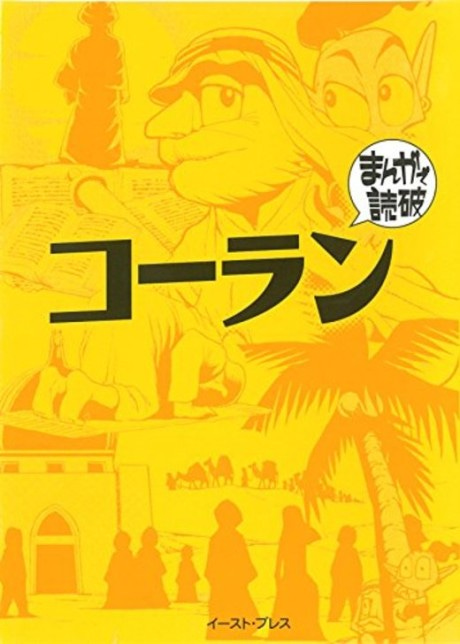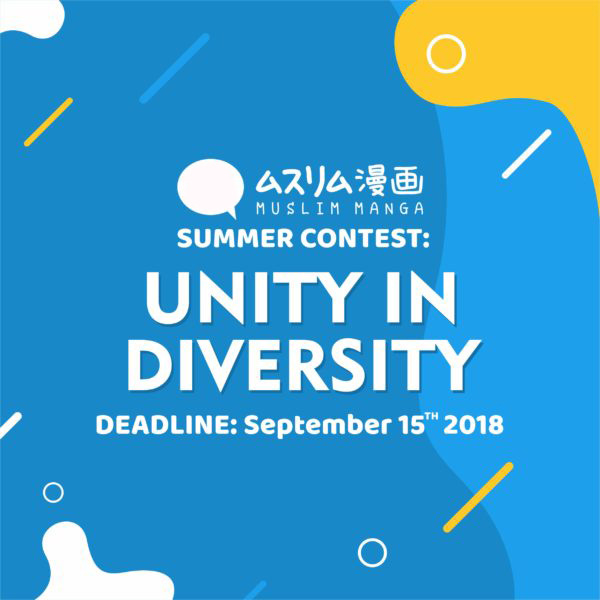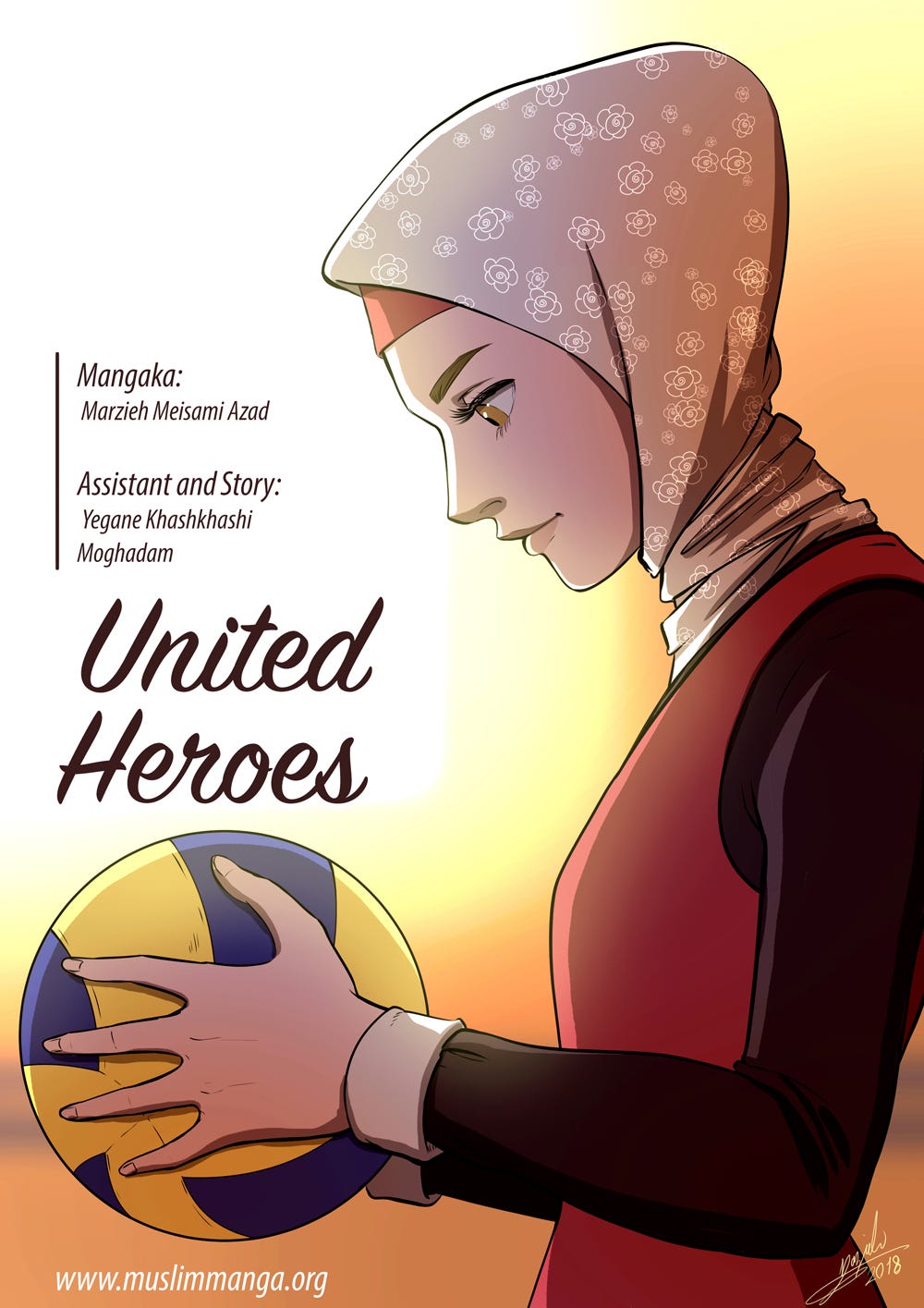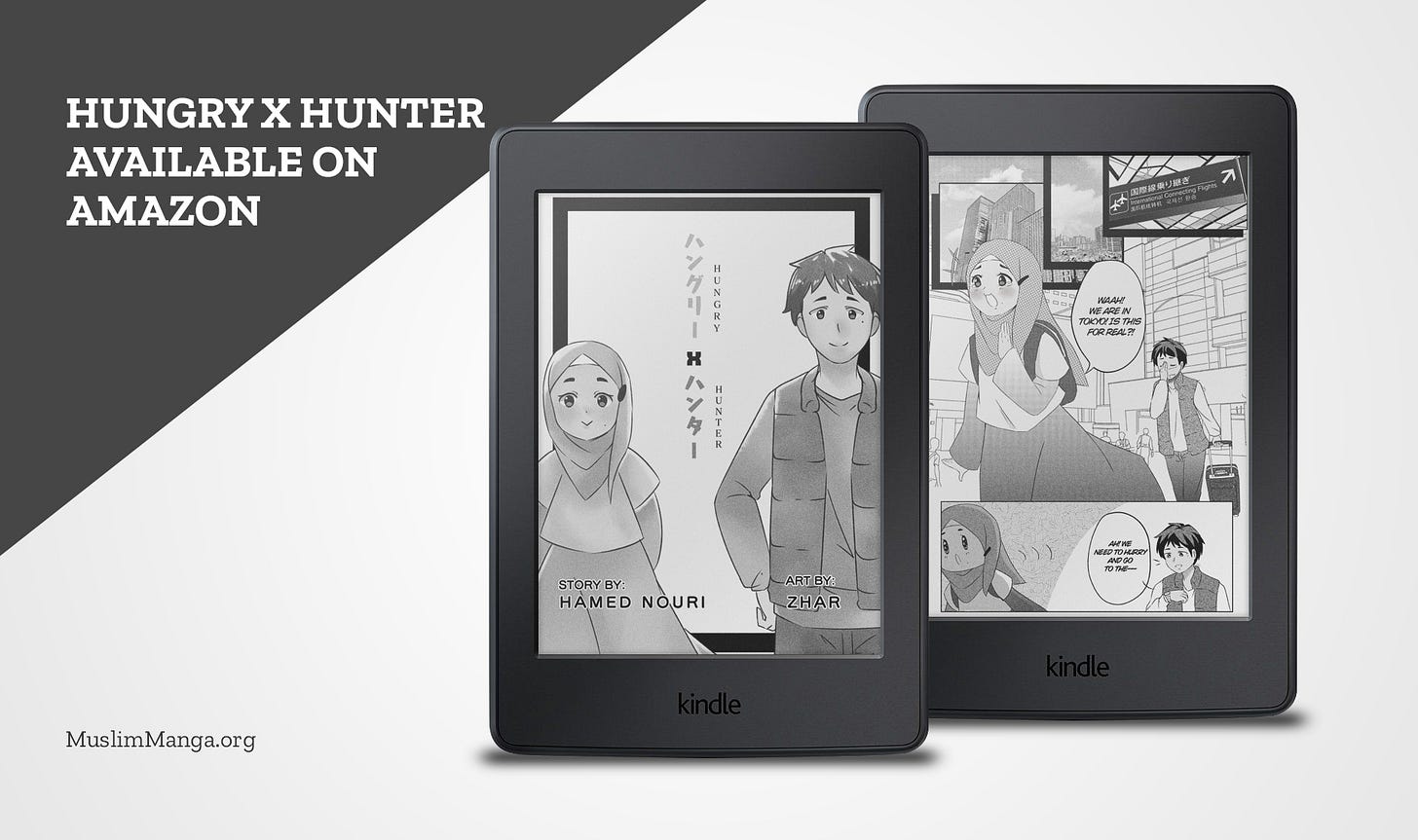Manga x Muslim World
International Forum held in Tokyo, November of 2018
On November 10th, 2018 there was an international forum held in Tokyo with in-person on the topic of Manga and the Muslim World.
The Overview
The primary target audience for the event was Japanese and all the programs and presentations were optimized for Japanese people. Presentations were all in Japanese or accompanied by English translations via translators or subtitles, in the case of video presentations.
The program included a mixture of in-person presentations, recorded presentations, Q and A sessions, as well as a gallery of comics and artwork by the Muslim Manga community and by guest presenters. Presentations were from Japan, the United States, Germany, and Iran, Bangladesh, and The Philippines, and comic submissions from the same countries plus from Malaysia and Indonesia as well. In-person presenters included the editor from the Banmikas team, responsible for the Quran manga, and Manaru Tenkawa, a manga professional with a Muslim character-focused manga, Hana Hana. Video presenters included Soufeina Hamed (AKA Tuffix), the author of Wiggle Wissal, The Sign as well many as many other comic-strips, and Ahmad Phillips, the comic artist, and animator of The Muslims comic and animation.
The goal of the forum was to establish an understanding of the work that is already being done in the field of Islamic Comics or even Muslim based comics, and to then discuss why and how to make such manga, based on the target audience, whether it is a Muslim audience or non-Muslim Japanese audience. The Manga x Muslim World forum was very much geared to be an educational experience on these topics.
The Begining
While in Tokyo, I found a group of friends who were very much multicultural Muslims and were very passionate about promoting the understanding of true Islam. I had the backing of these friends and their connections while preparing for this event. Actually preparing for the event started while I was in the United States visiting some family members. I had taken a little vacation from work and was relaxing. All of a sudden I was contacted by one of my friends with this idea of doing a forum/conference. I always thought of doing some sort of presentation or showcase of my work in Japan, but I hadn’t quite visualized how to go about it, until that moment.
Contacting Guests
I started contacting a lot of people who I thought would be interested in participating in this event, including friends and acquaintances from the UK, Malaysia, and the United States. There was a lot of back and forth emails and messages going and some people who got busy for whatever reason and others who just bailed out at the last minute, but alhamdulillah, we did get many wonderful guests who accepted to participate.
Manaru Tenkawa
On a prior trip to Japan in 2015, I spent 2 months traveling from the North of Japan to the south, making a documentary about Japan and Islam, interviewing both Japanese Muslims, immigrant Muslims, as well as Japanese people who had come in contact with Islam or Muslim culture in some form or fashion. Through this project, I met Manaru Tenkawa.
Her manga, Hana Hana tells the tale of an Arab Muslim high school student who travels overseas to Japan. Tenkawa-san also does a lot of workshops in Arab speaking countries. I kept in touch with her every once in a while and asked her to join us in the Manga x Muslim World Forum and she accepted. (By the way, it is just a coincidence that this manga’s character’s name is also Hana. The story is not related to Hana & Love. )
Team Banmikas Editor
Another person we invited was the editor of the Quran manga, published in Japan. I remember reading about this manga years ago and the internet was filled with rumors and speculations. Some Muslim commenters on internet articles or social media were “offended”, assuming and accusing the manga makers of drawing the Prophet of Islam. Other western non-Muslim commenters were mentioning how this would be super controversial. Apparently, all these comment warriors never actually dug below the surface level. No one read the manga. I guess I can’t blame them. The comic is available in the Japanese language only and few people would want to pay for the comic if they can’t understand it. As far as I understand, the so-called controversy was just limited to a few internet articles and their comment section.
On the other hand, there is a problem with the comic, but it is not what you think, and there are a few interesting discussion points around the creation of this particular manga. So first of all, contrary to the western internet speculations, the writers and editors were extremely cautious about how they would create this manga, trying their best not to offend any Muslims. They consulted with multiple Muslim organizations as well while making the manga. One particular issue was of course not being able to show the Prophet of Islam’s face. Luckily for the manga makers, there was already a precedent in the manga publishing world with manga character who’s face would never be shown. This character would always wear a mask, and if his mask was ever removed, there would just be light shown. Something similar is drawn in a lot of Middle Eastern countries when drawing the Prophet Mohammad (PBUH) for Islamic education material. They would never draw his face out of respect for him. This manga did something similar to that. The issue with the comic is the choice of art style. One concern I heard is that the manga is drawn in a very cartoonish almost dishy-like style. The problem with that is that it gives the illusion of mythology or fairytale, instead of historical.
The Flyer
Contacting guests was one thing. The other was to reach out to media outlets and inviting Japanese audience members as well. We also created a website and flyer for the event. The flyer itself has a little comic in it.
The comic had many iterations before it made it to the final version. The flyer comic has quite an interesting story to it. It shows two people, one Japanese otaku who is familiar with all the types of manga, including “Muslim Manga”, while the other character is a Muslim who doesn’t really know much about manga. They bump into each other and the otaku guy drops his book. This is where these two worlds kind of collide.
After that was prepared, we had to prepare a gallery filled with comic submissions. This included many cute episodes from the Journey of a Muslim series as well as Muslim Manga Club, Hungry X Hunter, and many submissions from the Unity in Diversity Manga Contest. Many of the submissions were printed on special paper and put in glass frames. Others were printed on canvas and framed just like that.
Unity in Diversity Contest
To go along with the conference which was being planned for many months in advance, we started the Unity in Diversity Contest on Muslim Manga. I started this in the early phases, in the summer of 2018.
To participate in the event, the submitters were tasked with creating a manga consisting of at least 10 pages. The theme of the contest was “Unity in Diversity”. Participants’ works had to include one or more of the following topics.
Muslims growing up in a Muslim predominant country.
Muslims in a non-Muslim predominant country.
Life of a Muslim in Japan.
Racism among Muslim communities.
Racism targeted towards Muslims.
Life of a Muslim revert.
Life of a Muslim Refugee.
The winners of the contest would get a graphics tablet and have their works featured in the gallery in Tokyo.
The winners
There were many great submissions, but ultimately winners had to be chosen and the winners of the contest were United Heroes, Return, and Refugee Olympics.
United Heroes is a Sports Manga. Made by Marzieh Meisami Azad and Yegane Khashkhashi Moghadam. It has become the Champion winning the Unity in Diversity Manga Contest! A story showing the struggle between one’s dream and staying true to oneself. Read the manga here.
Return won second place at the Muslim Mangas Unity in Diversity Manga Contest! A relatable story by Kolah showing the struggle many female Muslims face, when looking for a job. Read the manga here.
Refugee Olympics“ is a heart-touching Manga made by Mar and Khai Akhiar. As a result, it won third place in the Muslim Manga Unity in Diversity Contest!
Follow your dreams! But starting with the usual Sprinting, our hero is running into a dark corner of a dark memory… Read the manga here.
Hungry x Hunter
To go along with the Unity in Diversity contest and the upcoming Manga x Muslim World Forum, I worked with my artist partner, Zhar, to create a new one-shot comic, titled Hungry X Hunter. One of the reasons I wrote the story for this manga is because after lived in Japan, I felt that one of my previous stories, The Will of Fawwaz, may have been perceived as portraying Japanese people negatively because there are some characters who are a bit Islamaphic. Here is a summary of the manga:
Zahara accompanies her brother Zohair to Tokyo to help him settle in before his university life starts. When the two arrive, they struggle to find food. Read this story to find out how people of different cultural, religious, and language backgrounds connect over food.
You can buy it on Amazon Kindle and Comixology today.
The Day of the Event
On the day of the presentations, I got up early and was practicing my presentations, but I was nervous. Once I got to the venue, I realized there were also NHK news reporters there who just came for my presentation. That didn’t help with being nervous. But a funny story happened there. At first, I was standing by the podium which was on the right side of the stage, and so the reporters set up their equipment angled to record me there, but when I saw other presenters were more relaxed and confident and in the center, I did the same. So, I might have caused a minor annoyance with the reporters who positioned themselves specifically to get the right side of the stage. But I saw the footage. It looked ok!
In our presentations, we divided up Islamic manga into four categories, a follows:
Fiction
Historical/Cultural
Muslim daily life
Islamic teaching
We also discussed two different audiences, a Japanese audience, and a Muslim audience, and how each audience had their own needs or requirements as far as content goes.
One of the first presentations discussed the 4 Islamic manga categories created by Japanese authors, including The Heroic Legend of Arslan for fiction, Satoko and Nada for the Muslim daily life category, and the Quran manga for the Islamic teaching category. As for the manga created by Muslim authors, we discussed Samurai Akiyama, the Gold Ring, and The Pious Student, among other titles.
We divided the two audiences and the Islamic categories into 3 zones. We classified zone 3, which was the fiction and historical/cultural for a Japanese audience, as the easiest zone for non-Muslims/Japanese people to make. We classified, zone 2 which covered fiction and historical/cultural for a Muslim audience as well as Muslim daily life for both Muslim and Japanese audience as the zone which was a little more challenging to get right, but not quite as difficult and challenging as zone 1, which is creation Islamic teaching manga, both for Japanese audience as well as for a Muslim audience.
Controversial Cartoons
Obviously in this day and age, due to uproar around the world with regard to controversial cartoons, a lot of Japanese comic artists may be cautious, uncomfortable, or even scared when attempting to draw anything Muslim related.
All of the three zones that we mentioned assume that the intention of the maker of the manga is positive. If there is no offense or evil intent, then there is nothing to be worried about.
A lot of the controversy that happens in the world with regard to Muslims and cartoons these days. This is because certain western cartoonists intentionally provoke the Muslim community as a whole with offensive material. The purpose of such vulgar and hateful material is indeed to offend and hurt Muslims. If anyone’s intention is positive and amicable, then there will be no controversy.
The three Zones and Muslim Sensitivities
Zone 3 is the easiest zone to make, as it would cause no offense to Muslims, as this category doesn’t need to be accurate and the audience is not Muslim, so they wouldn’t notice any mistakes that you might make with regard to the character or world you have made, as far as how realistic it is or how culturally correct it is.
Zone 2 is primarily with a Muslim audience. If you want to connect with a Muslim audience who has lived as a Muslim for many years, then you have to be very careful, otherwise, you risk a disconnect with the audience. They won’t necessarily get offended, but instead of having the audience emerged in your world, you will have them thinking about the mistakes you made and how “that is not how Muslims are”, etc. Zone 2 also includes Muslim daily life for a Japanese audience. This is partly because Muslims care about how they are portrayed, given how the world has so much misinformation about Muslims. Muslims want to be portrayed fairly and accurately. Zone 1 is the most sensitive area because it is dealing with teaching Islam. Not only would Muslims be concerned about the validity of the information being taught, but also as far as manga goes, there are a lot of sensitive things that are not even allowed to be drawn in Islam, such as God or the Holy Prophet.
Examples of Sensitivities
I wrapped up my presentation by going over some examples of scenarios and discussed the level of sensitivity involved. Here are a few of the examples I brought up
Danish cartoon of Prophet Mohammad (PBUH) as a bomb.
This is highly sensitive and offensive. Obviously, this cartoon or anything similar to this is created for mockery and with the intention to offend Muslims, so it is no surprise that this would be categorized as highly sensitively. The Prophet of Islam is illustrated which makes Muslims uncomfortable, and moreover, it is illustrated poorly and offensively, linking the Prophet of Islam, the epitome of peace, love, to violence, bloodshed and vulgarity.Jo Jo’s Bizzarre adventures anime scene where the evil character is seen reading the Holy Quran.
This is quite sensitive too. Through visual composition, it is linking the holy Quran with an evil character. Moreover, in the original manga version, the text was not the Quran.
Portraying the Prophet of Islam beautifully:
This one might be something some of the readers may disagree with, but we discussed that this is something sensitive because as Muslims we do not do that and that we are not happy that that is done, but we also discussed that it is not necessarily offensive. Sensitive, but not offensive.
I’d like to end this newsletter by sharing a couple of video presentations by Tuffix and Ahmad Phillips. Make sure to subscribe to our YouTube channel for more videos like this as well as other content.
Watch Ahmad Philips’s Manga x Muslim World Presentation on youtube.
Watch Tuffix’s Manga x Muslim World Presentation on youtube.
Thank you for reading.
If you enjoyed this, please make sure to subscribe to the newsletter.
If you want to follow, you can do so by following us @MuslimManga on Instagram, Facebook, and Twitter.
If you’d like to send us an email, please contact us via info@muslimmanga.org













As-salamu Alaykum, I'm very happy to know that there is a Muslim manga! Your story is very motivational. You gave me hope, I was very disappointed because I find only few Muslim illustrators who draw about Islam! So I'm proud of you, keep up your great work and message. And surely, one day I'd join you!